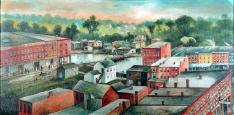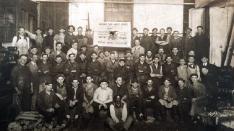 Courtesy of Allen County-Fort Wayne Historical Society Irish immigrants dug much of the Wabash & Erie Canal, which dominated downtown Fort Wayne in this view from 1866. This painting, copied from a photo by J.H. Dille, shows the view from the old Allen County Courthouse looking north where Harrison Street crossed the canal. |
 Courtesy of Allen County-Fort Wayne Historical Society Irish immigrants were part of the backbone of laborers in the Pennsylvania Railroad shops. Above are members of the machine-shop night force marking success during a World War I Liberty Bond campaign in 1918. |